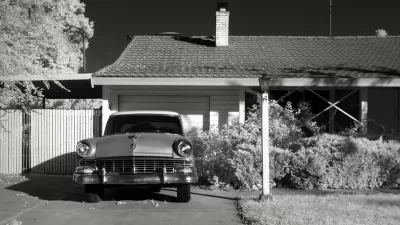The nation has a huge quantity of postwar housing that can be made more walkable and appealing to new generations of residents. Robert Steuteville examines what makes them good candidates and notes some examples of successful retrofits.

"World War II has long been considered the watershed for automobile-oriented development. Suburbs were built prior to the war, but largely were mixed-use, walkable towns and neighborhoods of the 'streetcar suburb' variety."
"After 1945, development shifted radically — to automobile-oriented housing with various types of single-use commercial development along arterial highways."
"Yet this binary view — traditional neighborhoods before the war; suburban sprawl afterward — obscures differences in postwar suburban patterns that can exert a critical impact on revitalization. Planners and theorists have in recent years been debating how to fix the suburbs, as discussed in books such as Retrofitting Suburbia by Ellen Dunham-Jones and June Williamson, and Sprawl Repair Manual by Galina Tachieva. This year, Arthur C. Nelson in Reshaping Metropolitan America made the demographic case that redevelopment of low-density commercial buildings – largely in the suburbs — could meet all of the US new housing needs in the coming decades."
"As successful case studies pile up, demonstrating the high returns generated by redevelopment associated with Leave it to Beaver neighborhoods," concludes Steuteville, "more public funds could be allocated into remaking the 'corridors of crap' into main streets. This, in turn, could generate momentum for bringing new life to the suburbs built after World War II and make US metropolitan regions more sustainable, appealing, and economically viable."
FULL STORY: Postwar neighborhoods are key to suburban revitalization

Trump Administration Could Effectively End Housing Voucher Program
Federal officials are eyeing major cuts to the Section 8 program that helps millions of low-income households pay rent.

Planetizen Federal Action Tracker
A weekly monitor of how Trump’s orders and actions are impacting planners and planning in America.

Ken Jennings Launches Transit Web Series
The Jeopardy champ wants you to ride public transit.

California Invests Additional $5M in Electric School Buses
The state wants to electrify all of its school bus fleets by 2035.

Austin Launches $2M Homelessness Prevention Fund
A new grant program from the city’s Homeless Strategy Office will fund rental assistance and supportive services.

Alabama School Forestry Initiative Brings Trees to Schoolyards
Trees can improve physical and mental health for students and commnity members.
Urban Design for Planners 1: Software Tools
This six-course series explores essential urban design concepts using open source software and equips planners with the tools they need to participate fully in the urban design process.
Planning for Universal Design
Learn the tools for implementing Universal Design in planning regulations.
Ada County Highway District
Clanton & Associates, Inc.
Jessamine County Fiscal Court
Institute for Housing and Urban Development Studies (IHS)
City of Grandview
Harvard GSD Executive Education
Toledo-Lucas County Plan Commissions
Salt Lake City
NYU Wagner Graduate School of Public Service


























